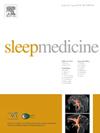The association of odds ratio product with respiratory and arousal measures in post-stroke patients
IF 3.8
2区 医学
Q1 CLINICAL NEUROLOGY
引用次数: 0
Abstract
Study objectives
Obstructive Sleep Apnea (OSA) affects up to 70 % of post-stroke patients, complicating recovery and rehabilitation. This study aimed to evaluate the utility of the Odds Ratio Product (ORP), a continuous EEG-derived metric of sleep depth, in predicting conventional respiratory and arousal measures in stroke patients. We hypothesized that ORP metrics will predict conventional measures in patients with a history of stroke or Transient ischemic attack (TIA).
Methods
A retrospective analysis was conducted on 113 stroke/TIA individuals who underwent in-laboratory polysomnography (PSG). ORP metrics, including ORPnrem, ORPrem, ORP9, and Wake Intrusion Indices (WIIs), were analyzed using multivariate linear regression models. Models were stratified by OSA status. Standardized coefficients were used to assess associations with the apnea-hypopnea index (AHI), respiratory disturbance index (RDI), and arousal indices.
Results
ORP metrics demonstrated statistically significant associations with conventional respiratory and arousal measures, with varying predictive strength across models. Specifically, ORPnrem and WIIs exhibited strong predictive effects across all models. ORP9 significantly predicted respiratory and arousal measures in the overall sample and the OSA subgroup, but its predictive value diminished in the non-OSA subgroup. ORPrem was statistically significantly associated with respiratory and arousal measures; however, its associations with arousal measures were weaker in participants with OSA compared to those without OSA.
Conclusion
ORP metrics have the potential to refine OSA diagnoses and improve therapeutic strategies in post-stroke/TIA populations. Their integration into sleep assessments could facilitate early intervention and potentially optimize stroke recovery outcomes, addressing gaps in current evaluation methods.
脑卒中后患者呼吸和觉醒测量的比值比
研究目的阻塞性睡眠呼吸暂停(OSA)影响高达70%的卒中后患者,使恢复和康复复杂化。这项研究旨在评估优势比积(ORP)的效用,ORP是一种连续的脑电图衍生的睡眠深度指标,用于预测中风患者的常规呼吸和觉醒测量。我们假设ORP指标可以预测卒中或短暂性脑缺血发作(TIA)病史患者的常规指标。方法对113例脑卒中/TIA患者进行室内多导睡眠图(PSG)回顾性分析。ORP指标包括ORPnrem、ORPrem、ORP9和尾流入侵指数(WIIs),采用多元线性回归模型进行分析。根据OSA状态对模型进行分层。标准化系数用于评估与呼吸暂停低通气指数(AHI)、呼吸障碍指数(RDI)和觉醒指数的关联。结果sorp指标与传统的呼吸和觉醒测量具有统计学上的显著相关性,不同模型的预测强度不同。具体来说,ORPnrem和WIIs在所有模型中都表现出很强的预测作用。ORP9在整体样本和OSA亚组中显著预测呼吸和觉醒测量,但在非OSA亚组中其预测价值降低。ORPrem与呼吸和觉醒测量有统计学显著相关;然而,与没有阻塞性睡眠呼吸暂停的参与者相比,它与觉醒测量的关联较弱。结论orp指标有可能改善卒中/TIA后人群的OSA诊断和改善治疗策略。将它们整合到睡眠评估中可以促进早期干预,并有可能优化中风恢复结果,解决当前评估方法中的差距。
本文章由计算机程序翻译,如有差异,请以英文原文为准。
求助全文
约1分钟内获得全文
求助全文
来源期刊

Sleep medicine
医学-临床神经学
CiteScore
8.40
自引率
6.20%
发文量
1060
审稿时长
49 days
期刊介绍:
Sleep Medicine aims to be a journal no one involved in clinical sleep medicine can do without.
A journal primarily focussing on the human aspects of sleep, integrating the various disciplines that are involved in sleep medicine: neurology, clinical neurophysiology, internal medicine (particularly pulmonology and cardiology), psychology, psychiatry, sleep technology, pediatrics, neurosurgery, otorhinolaryngology, and dentistry.
The journal publishes the following types of articles: Reviews (also intended as a way to bridge the gap between basic sleep research and clinical relevance); Original Research Articles; Full-length articles; Brief communications; Controversies; Case reports; Letters to the Editor; Journal search and commentaries; Book reviews; Meeting announcements; Listing of relevant organisations plus web sites.
 求助内容:
求助内容: 应助结果提醒方式:
应助结果提醒方式:


